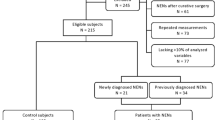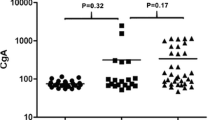Abstract
CgA is a tumor marker in NET's (neuroendocrine tumors) but different ranges of sensitivity and specificity according to the commercial assay kits used have been reported. Our aim was to compare three commercial available assay kits that use three different methodologies (IRMA, RIA and ELISA) to determine CgA, in a clinical setting: 52 healthy people, 98 patients with benign diseases, 94 patients with non-NET´s malignancies, 20 SCLC and in 79 patients with NET's. Results: Using a cut-off with a 100% specificity in healthy people (6 nmol/L, 60 ng/ml, and 90 ng/ml, for RIA, ELISA and IRMA, respectively), abnormal serum concentrations of CgA were found in a high proportion of patients with renal failure (76.7% ,86,7% and 93.3% with ELISA; IRMA and RIA, respectively) other benign diseases (excluding patients with creatinine concentrations > 1.5 mg/dl)(40,3%, 50% and 53,2% with ELISA, IRMA and RIA, respectively) or in patients with non-NET´s malignancies (excluding SCLC and patients with renal failure) (59,8% ELISA, 55,4%% IRMA, 37% RIA). The highest CgA sensitivity in SCLC was obtained with ELISA (100%) and in NET´s with ELISA (83.3%) and IRMA (80.3%) (RIA 65.2%). ROC curves comparing healthy people and NET´s or NET´s- benigns showed a significantly higher area under the curve (AUC) with ELISA (0.964 and 0.774), or IRMA (0.955 and 0.785), and smaller with RIA (0,806 and 0.691). Conclusions: CgA is not a specific tumormarker and abnormal concentrations may be found in non-NET´s. The higher AUC, sensitivity and specificity obtained with the ELISA and IRMA indicates that these are the best techniques to determine CgA.


Similar content being viewed by others
References
McDermott EW, Guduric B, Brennan MF. Prognostic variables in patients with gastrointestinal carcinoid tumours. Br J Surg. 1994;81:1007–9.
Soga J. Carcinoids and their variant endocrinomas. An analysis of 11842 reported cases. J Exp Clin Cancer Res. 2003;22:517–30.
Williams ED, Sandler M. The classification of carcinoid tumours. Lancet. 1963;1:238–9.
Deftos LJ. Chromogranin A: its role in endocrine function and as an endocrine and neuroendocrine tumor marker. Endocr Rev. 1991;12:181–7.
Oberg N, Stridsberg M. Neuroendocrine tumors. In: Diamandis EP, Fritsche HA, Lilja H, Chan DW, Schwartz MK, editors. Tumor markers: physiology, pathobiology, technology and clinical applications. Washington: American Association for Clinical Chemistry Press; 2002. p. 339–50.
Campana D, Nori F, Piscitelli L, Morselli-Labate AM, Pezzilli R, Corinaldesi R, et al. Chromogranin A: is it a useful marker of neuroendocrine tumors? J Clin Oncol. 2007;25:1967–73.
Bajetta E, Ferrari L, Martinetti A, Celio L, Procopio G, Artale S, et al. Chromogranin A, neuron specific enolase, carcinoembryonic antigen, and hydroxyindole acetic acid evaluation in patients with neuroendocrine tumors. Cancer. 1999;86:858–65.
Bashir S, Gibril F, Ojeaburu JV, Asgharian B, Entsuah LK, Ferraro G, et al. Prospective study of the ability of histamine, serotonin or serum chromogranin A levels to identify gastric carcinoids in patients with gastrinomas. Aliment Pharmacol Ther. 2002;16:1367–82.
Cimitan M, Buonadonna A, Cannizzaro R, Canzonieri V, Borsatti E, Ruffo R, et al. Somatostatin receptor scintigraphy versus chromogranin A assay in the management of patients with neuroendocrine tumors of different types: clinical role. Ann Oncol. 2003;14:1135–41.
Eriksson B, Arnberg H, Lindgren PG, Lorelius LE, Magnusson A, Lundqvist G, et al. Neuroendocrine pancreatic tumours: clinical presentation, biochemical and histopathological findings in 84 patients. J Intern Med. 1990;228:103–13.
Eriksson B, Oberg K, Stridsberg M. Tumor markers in neuroendocrine tumors. Digestion. 2000;62 Suppl 1:33–8.
Granberg D, Stridsberg M, Seensalu R, Eriksson B, Lundqvist G, Oberg K, et al. Plasma chromogranin A in patients with multiple endocrine neoplasia type 1. J Clin Endocrinol Metab. 1999;84:2712–7.
Nehar D, Lombard-Bohas C, Olivieri S, Claustrat B, Chayvialle JA, Penes MC, et al. Interest of chromogranin A for diagnosis and follow-up of endocrine tumours. Clin Endocrinol. 2004;60:644–52 (Oxf).
Nobels FR, Kwekkeboom DJ, Coopmans W, Schoenmakers CH, Lindemans J, De Herder WW, et al. Chromogranin A as serum marker for neuroendocrine neoplasia: comparison with neuron-specific enolase and the alpha-subunit of glycoprotein hormones. J Clin Endocrinol Metab. 1997;82:2622–8.
Seregni E, Ferrari L, Bajetta E, Martinetti A, Bombardieri E. Clinical significance of blood chromogranin A measurement in neuroendocrine tumours. Ann Oncol. 2001;12 Suppl 2:S69–72.
Stridsberg M, Eriksson B, Oberg K, Janson ET. A comparison between three commercial kits for chromogranin A measurements. J Endocrinol. 2003;177:337–41.
Tomassetti P, Migliori M, Simoni P, Casadei R, De Iasio R, Corinaldesi R, et al. Diagnostic value of plasma chromogranin A in neuroendocrine tumours. Eur J Gastroenterol Hepatol. 2001;13:55–8.
Borch K, Stridsberg M, Burman P, Rehfeld JF. Basal chromogranin A and gastrin concentrations in circulation correlate to endocrine cell proliferation in type-A gastritis. Scand J Gastroenterol. 1997;32:198–202.
Canale MP, Bravo EL. Diagnostic specificity of serum chromogranin-A for pheochromocytoma in patients with renal dysfunction. J Clin Endocrinol Metab. 1994;78:1139–44.
Ceconi C, Ferrari R, Bachetti T, Opasich C, Volterrani M, Colombo B, et al. Chromogranin A in heart failure; a novel neurohumoral factor and a predictor for mortality. Eur Heart J. 2002;23:967–74.
Fossmark R, Jianu CS, Martinsen TC, Qvigstad G, Syversen U, Waldum HL. Serum gastrin and chromogranin A levels in patients with fundic gland polyps caused by long-term proton-pump inhibition. Scand J Gastroenterol. 2008;43:20–4.
Giusti M, Sidoti M, Augeri C, Rabitti C, Minuto F. Effect of short-term treatment with low dosages of the proton-pump inhibitor omeprazole on serum chromogranin A levels in man. Eur J Endocrinol. 2004;150:299–303.
Hirschowitz BI, Worthington J, Mohnen J, Haber M. Chromogranin A in patients with acid hypersecretion and/or hypergastrinaemia. Aliment Pharmacol Ther. 2007;26:869–78.
O'Connor DT, Pandlan MR, Carlton E, Cervenka JH, Hslao RJ. Rapid radioimmunoassay of circulating chromogranin A: in vitro stability, exploration of the neuroendocrine character of neoplasia, and assessment of the effects of organ failure. Clin Chem. 1989;35:1631–7.
Peracchi M, Gebbia C, Basilisco G, Quatrini M, Tarantino C, Vescarelli C, et al. Plasma chromogranin A in patients with autoimmune chronic atrophic gastritis, enterochromaffin-like cell lesions and gastric carcinoids. Eur J Endocrinol. 2005;152:443–8.
Sanduleanu S, Stridsberg M, Jonkers D, Hameeteman W, Biemond I, Lundqvist G, et al. Serum gastrin and chromogranin A during medium- and long-term acid suppressive therapy: a case-control study. Aliment Pharmacol Ther. 1999;13:145–53.
Takiyyuddin MA, Parmer RJ, Kailasam MT, Cervenka JH, Kennedy B, Ziegler MG, et al. Chromogranin A in human hypertension. Influence Heredity Hypertens. 1995;26:213–20.
Waldum HL, Arnestad JS, Brenna E, Eide I, Syversen U, Sandvik AK. Marked increase in gastric acid secretory capacity after omeprazole treatment. Gut. 1996;39:649–53.
Houben P, Lundqvist G, Biedmond I, Jonkers D, Stockbrugger R. 24 hour intragastric ph, basal and meal-stimulated serum gastrin and plasma chromogranin A after short term acid inhibition. Gastroenterology. 1997;112 A 152.
Portela-Gomes GM, Stridsberg M. Selective processing of chromogranin A in the different islet cells in human pancreas. J Histochem Cytochem. 2001;49:483–90.
Stridsberg M, Hellman U, Wilander E, Lundqvist G, Hellsing K, Oberg K. Fragments of chromogranin A are present in the urine of patients with carcinoid tumours: development of a specific radioimmunoassay for chromogranin A and its fragments. J Endocrinol. 1993;139:329–37.
Zatelli MC, Torta M, Leon A, Ambrosio MR, Gion M, Tomassetti P, et al. Chromogranin A as a marker of neuroendocrine neoplasia: an Italian Multicenter Study. Endocr Relat Cancer. 2007;14:473–82.
Baudin E, Bidart JM, Bachelot A, Ducreux M, Elias D, Ruffie P, et al. Impact of chromogranin A measurement in the work-up of neuroendocrine tumors. Ann Oncol. 2001;12 Suppl 2:S79–82.
Schurmann G, Raeth U, Wiedenmann B, Buhr H, Herfarth C. Serum chromogranin A in the diagnosis and follow-up of neuroendocrine tumors of the gastroenteropancreatic tract. World J Surg. 1992;16:697–701.
Taupenot L, Harper KL, O'Connor DT. The chromogranin-secretogranin family. N Engl J Med. 2003;348:1134–49.
Bernini GP, Moretti A, Ferdeghini M, Ricci S, Letizia C, D'Erasmo E, et al. A new human chromogranin 'A' immunoradiometric assay for the diagnosis of neuroendocrine tumours. Br J Cancer. 2001;84:636–42.
Orr DF, Chen T, Johnsen AH, Chalk R, Buchanan KD, Sloan JM, et al. The spectrum of endogenous human chromogranin A-derived peptides identified using a modified proteomic strategy. Proteomics. 2002;2:1586–600.
Ferrari L, Seregni E, Lucignani G, Bajetta E, Martinetti A, Aliberti G, et al. Accuracy and clinical correlates of two different methods for chromogranin A assay in neuroendocrine tumors. Int J Biol Markers. 2004;19:295–304.
Mountain CF. Staging classification of lung cancer. A critical evaluation. Clin Chest Med. 2002;23:103–21.
Stahel RA, Ginsberg R, Haveman K, Havemann K, Hirsch FR, Ihde DC, et al. Staging and prognostic factors in small cell lung cancer: a consensus report. Lung Cancer. 1989;5:119–26.
Petterson F. Annual report on the results of treatment in gynecologic cancer, vol. 20. Stockholm: FIGO ed; 1988.
De Long ER, De Long DM, Clarke-Pearson DL. Comparing the areas under two or more correlated receiver operating characteristics curves: a non-parametric approach. Biometrics. 1988;44:837–45.
Stephan C, Wesseling S, Schink T, Jung K. Comparison of eight computer programs for receiver-operating characteristics analysis. Cl Chem. 2003;49:433–9.
Fisher JD. New York Heart Association Classification. Arch Intern Med. 1972;129:836.
Lamberts SW, Hofland LJ, Nobels FR. Neuroendocrine tumor markers. Front Neuroendocrinol. 2001;22:309–39.
Rozansky DJ, Wu H, Tang K, Parmer RJ, O'Connor DT. Glucocorticoid activation of chromogranin A gene expression. Identification and characterization of a novel glucocorticoid response element. J Clin Invest. 1994;94:2357–68.
Leon A, Torta M, Dittadi R, degli UE, Ambrosio MR, Delle FG, et al. Comparison between two methods in the determination of circulating chromogranin A in neuroendocrine tumors (NETs): results of a prospective multicenter observational study. Int J Biol Markers. 2005;20:156–68.
Degorce F, Goumon Y, Jacquemart L, Vidaud C, Bellanger L, Pons-Anicet D, et al. A new human chromogranin A (CgA) immunoradiometric assay involving monoclonal antibodies raised against the unprocessed central domain (145-245). Br J Cancer. 1999;79:65–71.
Bajetta E, Ferrari L, Procopio G, Catena L, Ferrario E, Martinetti A, et al. Efficacy of a chemotherapy combination for the treatment of metastatic neuroendocrine tumours. Ann Oncol. 2002;13:614–21.
Acknowledgments
We declare that this research was supported by Novartis Oncology Spain. Novartis Oncology Spain has no relationship with the commercial assays used in this study and no interest in the selection of one or another method, but was interested in the standardization of the method used in the different departments of Oncology in Spain. Novartis Oncology Spain is commercially related to treatments in neuroendocrine tumors, but not in their diagnosis. This collaboration did not prejudice the impartiality of the research.
All participants collaborated in the selection of samples and in the CgA determination.
Conflict of interest
Authors declare that there is no conflict of interest that could be perceived as prejudicing the impartiality of the research reported.
Author information
Authors and Affiliations
Corresponding author
Rights and permissions
About this article
Cite this article
Molina, R., Alvarez, E., Aniel-Quiroga, A. et al. Evaluation of chromogranin A determined by three different procedures in patients with benign diseases, neuroendocrine tumors and other malignancies. Tumor Biol. 32, 13–22 (2011). https://doi.org/10.1007/s13277-010-0085-x
Received:
Accepted:
Published:
Issue Date:
DOI: https://doi.org/10.1007/s13277-010-0085-x




